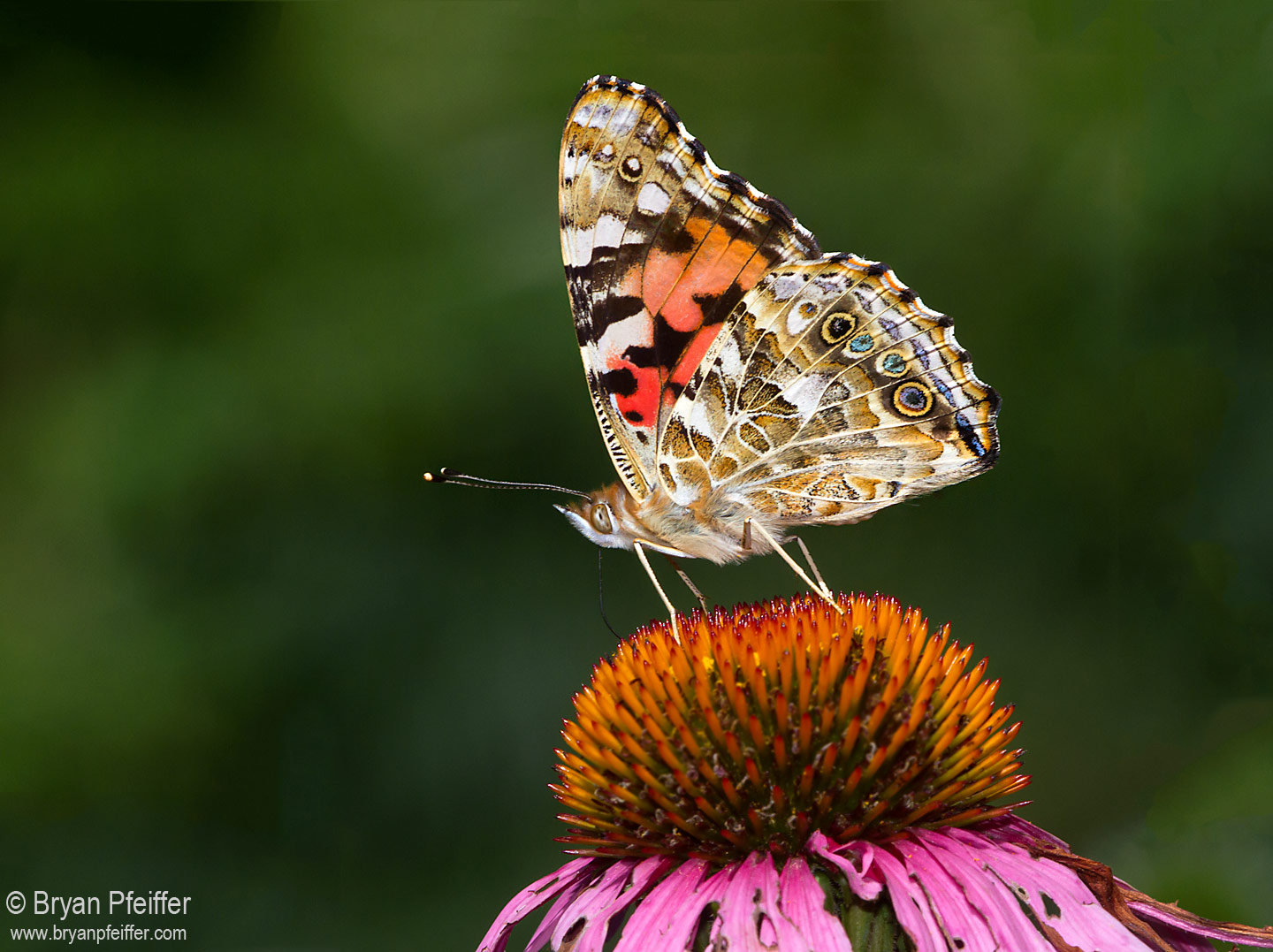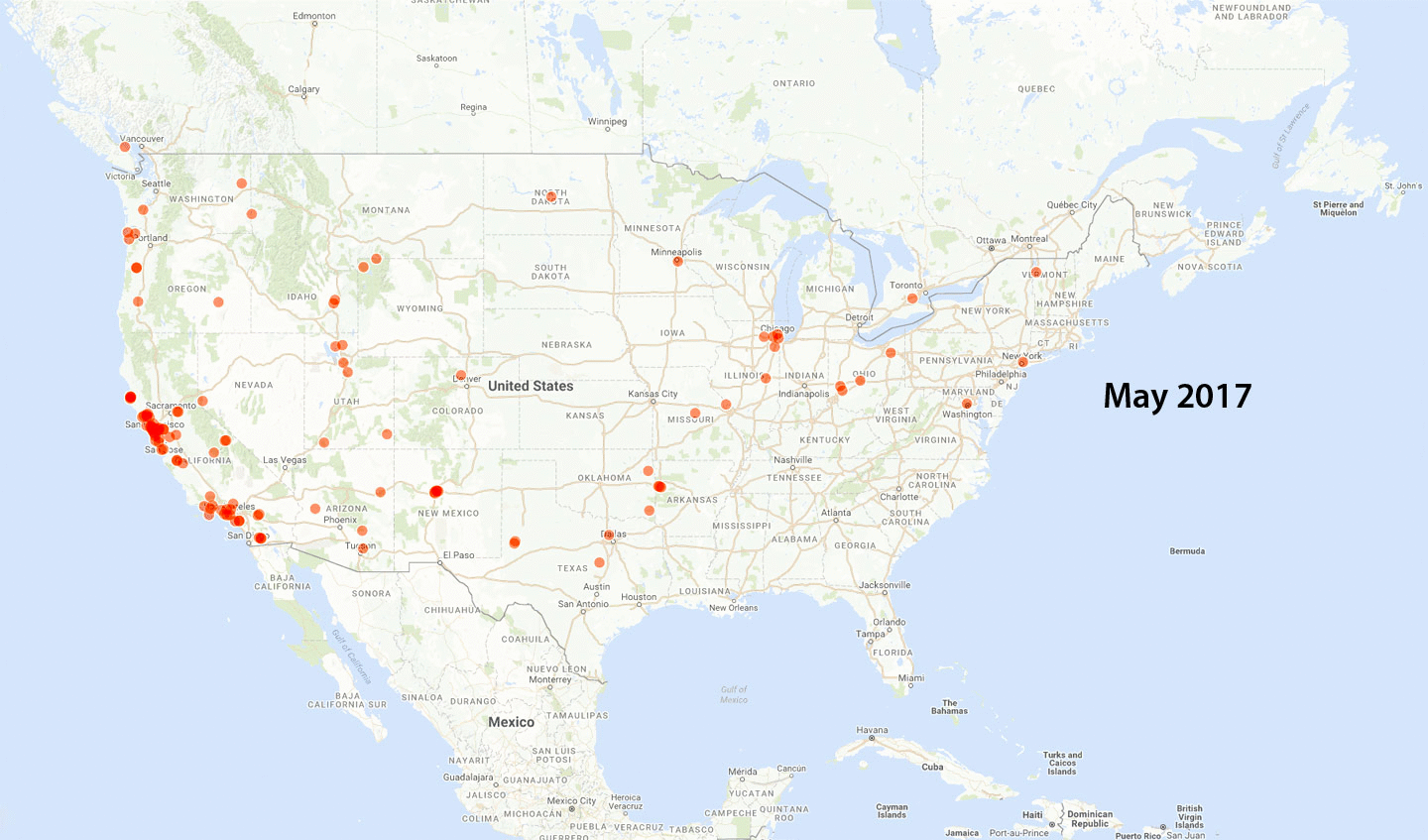Fly or Die: Painted Ladies on the Move

Blog Post Update – September 20, 2017: On August 8, I blogged about a flight of Painted Lady butterflies here in New England and elsewhere on the continent. I speculated that these were southbound migrants. Well, I was wrong. These ladies of August, present for about a week, were either northbound or a brood producing what is now the biggest fall Painted Lady flight I’ve ever seen. Nearly everywhere I walk here in Montpelier, including downtown, I’m finding these lovely butterflies. They’re more abundant now than Monarchs. So here’s an updated version of my post [with new text in brackets].
NOW PASSING YOU BY is one of the planet’s great events — an epic migration like no other. Not whales. Not birds. Not caribou. Painted Lady, the world’s most widespread butterfly, is on the move. We’ve been seeing them bigtime here in New England the past few weeks.

Painted Lady (Vanessa cardui) flies on every continent except Antarctica. From a vantage above, you see a fairly standard butterfly: lots of orange, black and white, with azure gems sometimes showing on the hind wings. Flashy and pleasant, to be sure.
But, ah, the Lady’s underside. Jackson Pollock and Peter Max might have been inspired (or envious). From below we receive a palette of peach and purple, almond and mauve, along with undulating white veins and dark edges. A fitting ornament atop that Purple Coneflower in our garden last week here in Montpelier.
Unlike lots of temperate butterflies, the Painted Lady has no tolerance for a freeze — certainly not as an adult, but neither as egg nor caterpillar nor chrysalis as well, which is how most of our butterflies get through the winter around here. So the Lady leaves.
“Migrants fly fast and straight, rising over obstacles in their path (from trees to six-storied buildings), rather than detouring around them,” write Rick Cech and Guy Tudor in their masterpiece Butterflies of the East Coast. “Migrants are encountered with some regularity at sea.”
We sometimes get great Painted Lady invasions — massive northbound flights — in the spring. The southbound flights generally aren’t as dramatic in terms of numbers. [This year they are.] One question is whether we’ve been [we were] seeing a northbound or southbound flight [in August]. Adults fly north from spring through July, returning south from late July or August into fall.¹ I suspect we’ve been seeing southbounders. [Now, in September, we’re seeing southbounders.]
What makes this butterfly so cosmopolitan isn’t only its peregrinations. It’s also diet. Unlike many butterflies, whose caterpillars feast only on one or more host plants, Painted Ladies are botanical omnivores; the caterpillars are known to survive on more than 100 species from about 10 plant families. Find them chewing on thistles (also a fine nectar source for adults), mallows, sunflowers and legumes, among other plant groups.
You can find the adults nectaring on anything they can find this fall. [They were sucking up Purple Coneflower nectar in August.] Now, in September, I’m seeing them on asters, goldenrods and common garden flowers. By the way, we’re getting a decent Monarch flight this fall as well.²
So enjoy the gossamer flights. And by all means kneel — or genuflect — for a glimpse of the Lady’s undersides.
[My colleague Kent McFarland at the Vermont Center for Ecostudies also reports on the Painted Lady flight and how you can help track it.]
Here are Painted Lady sightings reported to iNaturalist during May, June and July (along with the first week in August in that July map.) Note how we’re doing a good job finding and reporting them here in Vermont! [At the end of the month, I’ll add maps for August and September, which will no doubt be dense with Painted Ladies.]

Source: iNaturalist (http://www.inaturalist.org)
References
¹ The Butterflies of North America by James A. Scott.
² http://monarchwatch.org/blog/2017/07/20/monarch-population-status-31/

Yes, a good flight this spring!
They’re in the Sierra Mtns. Yosemite area.
Will you be updating the map for August and September?
I think we’re getting the tail end of the migration now.
I’ve never seen it like this in the fall. Amazing!
I am seeing them in great numbers here in ridgefield connecticut and last week on cape cod. reminds me of gthe red dmiral outbreak maybe three years ago although that was a northern spring event.
We were in Greenville Maine last week (Sept.23rd to Sept.30th) and the Painted Ladies were everywhere and as far north as the Ripogenus Gorge. They were moving south along Moosehead Lake.In the town garden they were feeding on Verbena bonariensis.
They were loving my autumn sedum and black eyed susan through most of this month. Gone now.
Yesterday, September 27th, I couldn’t count all the painted Ladies and Monarchs in my Northern Adirondack yard. I got some great pictures of the Pianted Ladies a few days ago, and some great monarch shots yesterday. GREAT article full of information.. thanks!
two days before a change in weather, Tues, 9/27, all of the painted ladies and the Monarchs disappeared from my garden. They put on a great display while they were here in my Calais Garden of Asters.
This is fantastic, Bryan. Thank you gathering the specifics on the Painted Lady. At work, Gardeners Supply, they have been all over the Sedum, Asters, and Echinacea this September. They have been so numerous and animated that I did a display by door to the outside in Perennials so everyone could watch them. It was an instant hit. I had done some research on my own to tell people about them, but your article says so much more. Thank You! I took a video of them in animation with bumble bees and honey bees on the display and put it on my Facebook page….. what a treat they have given us this year.
The extra beauty of this fall migration is that we have at times equal numbers of Painted Ladies and Monarchs!!! Hard to count accurately but at least 40 of each at one quick point count in the flower garden. They love Tithonia and Tall Vervain as well as most Zinnias and other blooms. What a lifetime thrill this is and it has been ongoing for many days.
There’s a Painted Lady convention going on in my garden, with crowds on the asters and verbena bonariensis.
Today, and for the last week, they are bumper to bumper with Monarchs on Tithonia (mexican sunflower), here in SW VT.
Lots of other pollinators as well.
Bryan, we are in the midst of a huge wave of Painted Ladies passing through. They are everywhere in big numbers, and I just counted 40 in our garden . It’s a once in a lifetime event, I’m sure, and one to treasure forever. Sue Gregoire
Yep. I think we had a surge. I’ll map them through a full season later this fall.
We had a lot on Echinacea at the end of July and beginning of August here in Bakersfield. None recently. They were joined with red admirals that are also nowhere to be seen now.
Should be a good Monarch flight. I’ve ordered 300 tags from MonarchWatch.
Thanks, Bob. Nice shot!
While visiting relatives in the NEK last week I saw several; here is a link to a pic of one that looks like a knockoff of your image:
https://goo.gl/DuYZL1
lovely creatures!
Hundreds out on Monhegan this past weekend! And more Monarchs than in the past few years, too, so maybe we’ll have more chrysalises to watch next month.
Great report from Maine. Thanks, Linda! Are you still seeing as many?
Hey Bryan! We have seen hundreds of these lovlies recently. They have been clustered on monarda, echinops and especially echinacea. Sometimes there will be 3 or 4 on a large flower! The bumbles just plow through however! Everybody crowds the lunch table in a friendly but pushy manner.
And blueberries! Yum!
But no bats.
Linda Wurm
Thanks, Erica. Any recently?
Dozens in my garden last week, too.